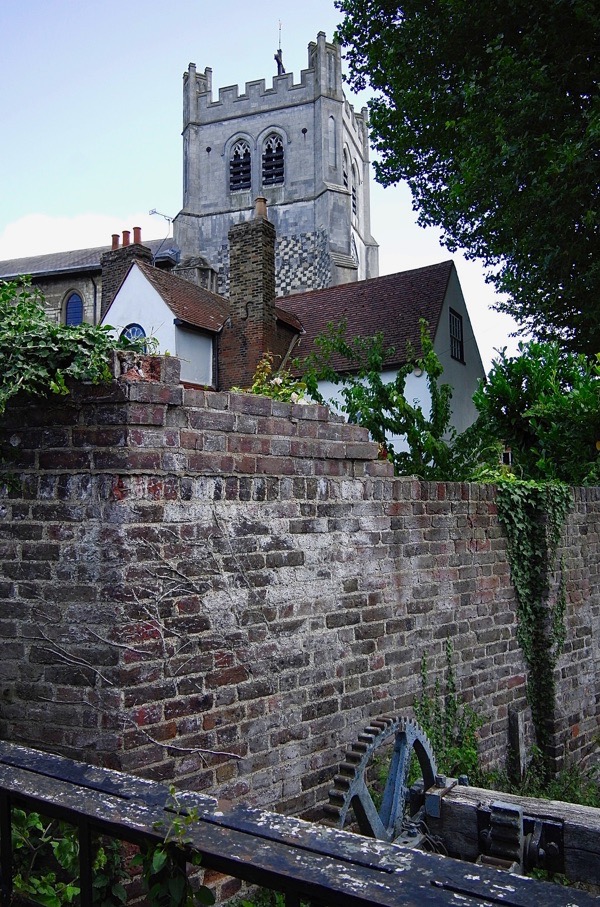At Waltham Abbey
Tickets are available for my walking tour today & Saturday
Click here to book for THE GENTLE AUTHOR’S TOUR OF SPITALFIELDS

I cycled along the River Lea to Waltham Abbey. On my approach, even from the riverbank, I could see the majestic tower rising over the water meadows as the Abbey has done for the past thousand years, commanding the landscape and undiminished in visual authority.
Once you see it, you realise you are following in the footsteps of the innumerable credulous pilgrims who came here in hope of miraculous cures from the holy cross, which had reputedly relieved Harold Godwinson of a paralysis as a child before he became King Harold.
To the south of the Abbey church lies the market square, bordered with appealingly squint timber frame buildings punctuated by handsome eighteenth and nineteenth additions. Despite the proximity of the capital, the place still carries the air of an English market town.
Yet the great wonder is the Abbey itself, founded in the seventh century, built up by King Harold and destroyed by Henry VIII. Despite the ravages of time, the grandeur and scale of the Abbey is still evident in the precincts which have become a public park. Although the church that impresses today is less than half the size of what it was, it is enough to fire your imagination. An imposing stone gateway greets the visitor to the park where long, battered walls outline the former extent of the buildings. A tantalising fragment of twelfth century vaulting, which formerly served as the entrance to the cloisters, encourages the leap to conjure the cloisters themselves where now is merely an empty lawn. A walled garden filled with lavender and climbing roses draws you closest to the spirit of the place.
The outline of the former Abbey church is marked upon the grass and at the eastern end lies a surprise. A plain stone engraved with the words ‘Harold King of England Obit 1066,’ indicating this is where legend has it that he was laid to rest after the Battle of Hastings. I realised that maybe the remains of the man in the tapestry, killed by the arrow in the eye, lay beneath my feet. Coming upon his stone unexpectedly halted me in my tracks.
This was one of those startling moments when there is a possibility of history being real, something tangible, causing me to reflect upon the Norman Conquest. A thousand years ago, their power found its expression in the vast complex of buildings here, which were destroyed five hundred years ago as the expression of another power.
We too live in a time of dramatic transition, emerging from the shadow of the pandemic and accommodating to our country’s divorce from Europe. I cycled from Spitalfields to Waltham Abbey as a respite from the times, yet here I was confronting it in a mossy green churchyard. The equivocal consolation of the historical perspective is that it reminds us that empires rise and fall, but life goes on.



Effigy of King Harold

Harold cradles Waltham Abbey in his arm




The Lady Chapel

Victorian villa in the churchyard

The Welsh Harp


These vaults are all that is left of the twelfth century cloisters




Here lies Harold, the last Anglo Saxon King of England

Waltham Abbey
You may also like to read about

















I loved this post! You are such a charming, graceful writer! I cannot believe how prolific you are.
Thank you GA for these most beautiful pictures that convey the peace and tranquillity of a place where ‘prayer has been valid’ for centuries and the weight of history evident in the crumbling stones. The story of King Harold is intriguing. I had no idea he was buried at Waltham Abbey!
The text is wonderfully written and the photos uplifting on a rainy English day.
One of my friends lives as a monk and so I seny the article to him for his perusal.
Thank you Gentle Author.
Andy
Long ago, when I was an adolescent, I walked up the Lea valley from Stole Newington to somewhere around Waltham Abbey. More than once. But sadly I lacked the information needed to appreciate the history of the places I passed. Now, of course, I am both too old and too far away to repeat the journey. Life has its sadnesses! Alas and alack!
Thank you, lovely photos. For information, could I just point out that the photo captioned The Welsh Harp is not a picture of The Welsh Harp. Yes, it does include the pub sign for The Welsh Harp above the Lych Gate, but the building in the photo is actually Lychgate House, a very interesting listed 16th century house with some Essex pargeting, weather boarding, jettied and timber framing. It has a varied history being at times a Curate’s home, a museum, and for many years it was Philpott’s Tearooms. It is now privately owned and operates as an air bnb.
Just thank you, for this truthful words
What a lovely interesting post. You wetted my appetite to visit the area’s charms